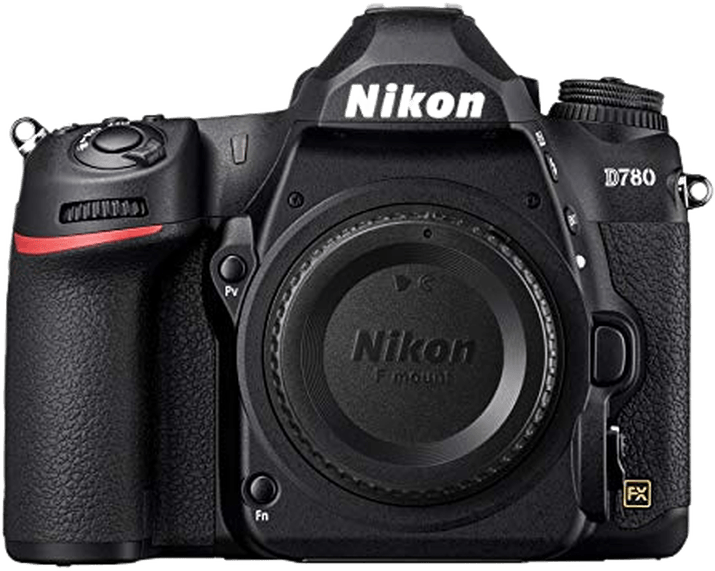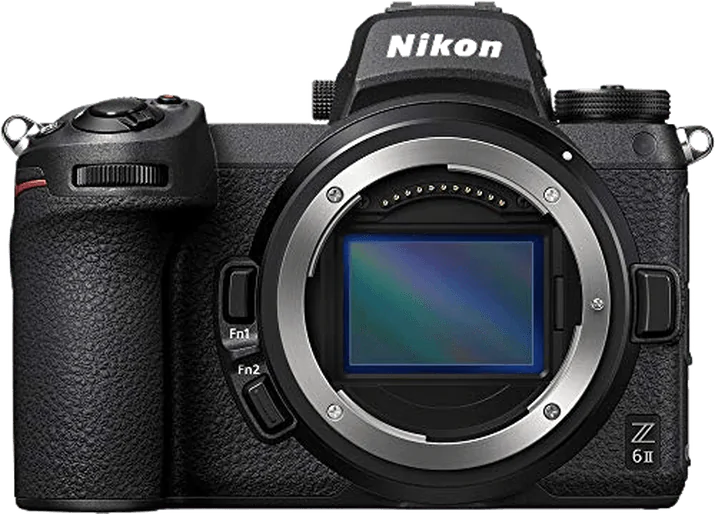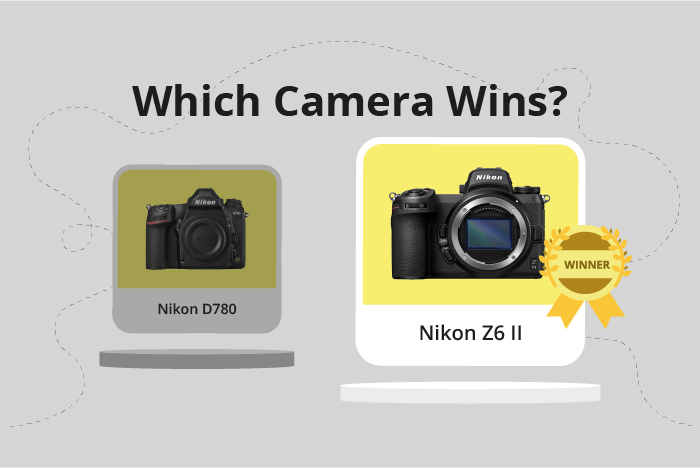Nikon D780 vs Z6 II Comparison
Nikon D780

Nikon Z6 II

The Nikon Z6 II takes the lead with a score of 83/100, while the Nikon D780 trails closely behind at 81/100. Both cameras, released in 2020, share similarities in specifications, such as their launch price, with the Z6 II at $1995 and the D780 at $2299.
The Z6 II stands out as a better option due to its mirrorless design, making it lighter at 705g (1.55lbs) and more compact with dimensions of 134 x 101 x 70mm. On the other hand, the D780 is a DSLR camera, weighing 850g (1.87lbs) and measuring 144 x 116 x 76mm, which may be preferable for those who prefer a heftier feel.
Considering the specifications, the Nikon Z6 II offers a more portable and convenient option, while the Nikon D780 caters to users who favor a traditional DSLR experience. Both cameras provide excellent performance, and the choice ultimately depends on personal preferences and priorities.
Nikon D780 vs Z6 II Overview and Optics
The Nikon Z6 II emerges as the winner in optics with a score of 83/100, while the Nikon D780 trails behind with a score of 77/100. Both cameras share some common specifications, such as a CMOS sensor, a full-frame sensor size, and an Expeed 6 processor. However, the Z6 II outperforms the D780 in certain aspects, making it the superior choice in terms of optics.
The Z6 II boasts 24.5 megapixels, a slightly lower count compared to the D780’s 25 megapixels, but it compensates with a faster shooting speed of 14 frames per second (fps) compared to the D780’s 12 fps. This higher shooting speed enables photographers to capture fast-moving subjects more effectively. Furthermore, the Z6 II features a Dual Expeed 6 processor, which contributes to better image processing and overall performance compared to the single Expeed 6 processor in the D780.
Another advantage of the Z6 II is its image stabilization feature, which the D780 lacks. This built-in stabilization ensures sharper images, especially in low-light conditions or when using slower shutter speeds. Additionally, the Z6 II uses a Nikon Z lens mount, which offers a wider range of compatible lenses and better optical performance compared to the Nikon F mount on the D780.
On the other hand, the D780 has a slightly higher DXOMARK score for its sensor at 97, compared to the Z6 II’s 94. This indicates that the D780’s sensor may deliver marginally better image quality in certain conditions. However, this difference is not significant enough to outweigh the Z6 II’s other advantages.
Given the Z6 II’s superior shooting speed, image stabilization, and lens compatibility, it is the better choice for photographers seeking optimal optical performance. While the D780 has a marginally higher sensor score, the Z6 II’s advantages make it the clear winner in terms of optics.
Nikon D780 vs Z6 II Video Performance
The Nikon D780 and Nikon Z6 II both have a video score of 91/100, indicating no clear winner in terms of video capabilities. These cameras share several important video specifications, such as a maximum video resolution of 4K, maximum video dimensions of 3840 x 2160, a maximum video frame rate of 120fps, and built-in time-lapse functionality.
Despite the equal scores, the Nikon D780 has some advantages over the Nikon Z6 II. For instance, the D780’s full-frame sensor allows for better low-light performance, capturing clearer and sharper images in less-than-ideal lighting conditions. This feature is particularly useful for videographers who often work in challenging lighting situations.
On the other hand, the Nikon Z6 II also offers some benefits compared to the D780. Its mirrorless design results in a lighter and more compact body, making it easier to handle and carry during extended video shoots. Additionally, the Z6 II’s in-body image stabilization helps to reduce camera shake, providing smoother and more stable footage.
Taking these factors into account, the Nikon D780 and Nikon Z6 II both excel in their video capabilities, with the D780 having a slight edge in low-light performance and the Z6 II offering the advantage of a more compact and lightweight design. Ultimately, the choice between these two cameras comes down to the specific needs and preferences of the videographer.
Nikon D780 vs Z6 II Features and Benefits
The Nikon D780 and Nikon Z6 II both have a feature score of 87/100. Both cameras share common specifications, such as a 3.2-inch screen size, touchscreen capability, the absence of GPS, and the presence of WIFI and Bluetooth connectivity. Despite their equal scores, each camera has distinct advantages.
The Nikon D780 surpasses the Z6 II with its higher screen resolution of 2,359,000 dots compared to the Z6 II’s 2,100,000 dots. This difference allows the D780 to display images with greater clarity and detail. Additionally, the D780 has a flip screen, providing more flexibility for shooting at various angles and aiding in self-portraits or vlogging.
On the other hand, the Nikon Z6 II does not have a flip screen, making it less versatile in certain situations. However, this does not necessarily mean that the Z6 II is inferior to the D780, as both cameras share the same feature score and perform equally well in other aspects.
Taking the shared specifications and individual advantages into account, both cameras are excellent choices for photographers. The Nikon D780 offers a higher screen resolution and a flip screen, making it more suitable for users who prioritize image clarity and versatility in composing shots. The Nikon Z6 II, while lacking a flip screen, maintains equal footing with the D780 in other features, making it a reliable option for those who do not require a flip screen for their photography needs.
Nikon D780 vs Z6 II Storage and Battery
The Nikon D780 outperforms the Nikon Z6 II in storage and battery, scoring 97/100 compared to the Z6 II’s 71/100. Both cameras feature two memory card slots, with the D780 accepting SD, SDHC, and SDXC (UHS-II compatible) cards, while the Z6 II takes SD, CFexpress Type B, and XQD (UHS-II compatible) cards.
The D780 boasts a significantly longer battery life of 2260 shots, using the EN-EL15b battery, while the Z6 II only manages 410 shots with its EN-EL15c battery. Both cameras offer USB charging capabilities.
Despite its lower score, the Z6 II has an advantage in supporting the faster CFexpress Type B and XQD memory cards, which can be beneficial for professional photographers requiring high-speed storage.
Considering these factors, the Nikon D780 provides superior battery life and reliable storage options, making it the better choice for extended shooting sessions. The Nikon Z6 II, however, may be more suitable for those prioritizing high-speed memory card compatibility.
Nikon D780 vs Z6 II – Our Verdict
Are you still undecided about which camera is right for you? Have a look at these popular comparisons that feature the Nikon D780 or the Nikon Z6 II:

